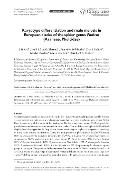Karyotype differentiation and male meiosis in European clades of the spider genus Pholcus (Araneae, Pholcidae)

Autor
Datum vydání
2022Publikováno v
Comparative CytogeneticsRočník / Číslo vydání
16 (4)ISBN / ISSN
ISSN: 1993-0771ISBN / ISSN
eISSN: 1993-078XMetadata
Zobrazit celý záznamKolekce
Tato publikace má vydavatelskou verzi s DOI 10.3897/CompCytogen.v16i4.85059
Abstrakt
Haplogyne araneomorphs are a diverse spider clade. Their karyotypes are usually predominated by biarmed (i.e., metacentric and submetacentric) chromosomes and have a specific sex chromosome system, X1X2Y. These features are probably ancestral for haplogynes. Nucleolus organizer regions (NORs) spread fre-quently from autosomes to sex chromosomes in these spiders. This study focuses on pholcids (Pholcidae), a highly diverse haplogyne family. Despite considerable recent progress in pholcid cytogenetics, knowledge on many clades remains insufficient including the most species-rich pholcid genus, Pholcus Walckenaer, 1805. To characterize the karyotype differentiation of Pholcus in Europe, we compared karyotypes, sex chromosomes, NORs, and male meiosis of seven species [P. alticeps Spassky, 1932; P. creticus Senglet, 1971; P. dentatus Wunderlich, 1995; P. fuerteventurensis Wunderlich, 1992; P. phalangioides (Fuesslin, 1775); P. opilionoides (Schrank, 1781); P. silvai Wunderlich, 1995] representing the dominant species groups in this region. The species studied show several features ancestral for Pholcus, namely the 2n male = 25, the X1X2Y system, and a karyotype predominated by biarmed chromosomes. Most taxa have a large acro-centric NOR-bearing pair, which evolved from a biarmed pair by a pericentric inversion. In some lineages, the acrocentric pair reverted to biarmed. Closely related species often differ in the morphology of some chromosome pairs, probably resulting from pericentric inversions and/or translocations. Such rearrange-ments have been implicated in the formation of reproductive barriers. While the X1 and Y chromosomes retain their ancestral metacentric morphology, the X2 chromosome shows a derived (acrocentric or sub-telocentric) morphology. Pairing of this element is usually modified during male meiosis. NOR patterns are very diverse. The ancestral karyotype of Pholcus contained five or six terminal NORs including three X chromosome-linked loci. The number of NORs has been frequently reduced during evolution. In the Macaronesian clade, there is only a single NOR-bearing pair. Sex chromosome-linked NORs are lost in Madeiran species and in P. creticus. Our study revealed two cytotypes in the synanthropic species P. phalan-gioides (Madeiran and Czech), which differ by their NOR pattern and chromosome morphology. In the Czech cytotype, the large acrocentric pair was transformed into a biarmed pair by pericentric inversion.
Klíčová slova
haplogyne, inversion, NOR, rDNA, sex chromosome, speciation, Synspermiata
Trvalý odkaz
https://hdl.handle.net/20.500.14178/1630Licence
Licence pro užití plného textu výsledku: Creative Commons Uveďte původ 4.0 International






